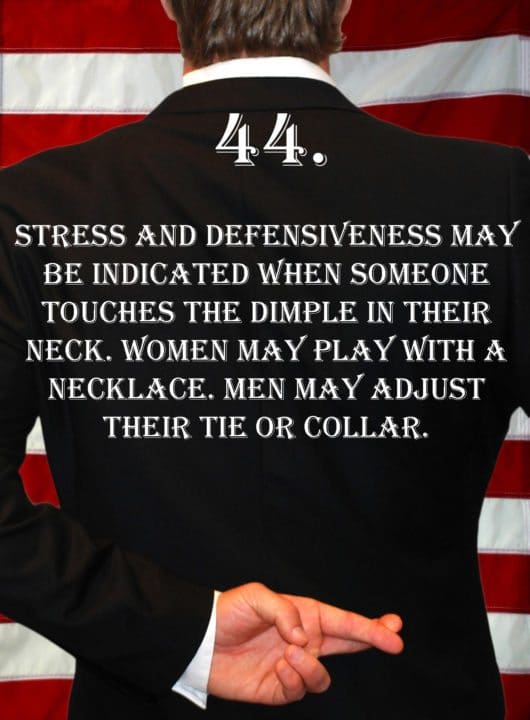
Deception Tip 44:
Stress and defensiveness may be indicated when someone touches the dimple in their neck. Women may play with a necklace. Men may adjust their tie or collar.
Listen To The Podcast!
E44 – Neck Dimple – Deception Tips Podcast – Click Here To Subscribe
Podcast Transcript
Hello and welcome to the deception tips podcast where you will learn amazing cues to detect deceit that will help you read people like never before. I’m your host Spencer Coffman, let’s get started.
Welcome to episode 44 of the deception tips podcast where you are learning how to read people and detect deception so that you will never be lied to again.
Obviously, you’re probably going to be lied to, it is something that happens every single day a number of times. In fact, a recent study stated that the average person lies about 200 times per day.
That is incredible and is a huge number, it is an average that hasn’t changed over the past five years. They estimate that people lie about two hundred times a day or five to ten times every 20 minutes of conversation.
So, that’s like one lie every two minutes, that is a lot of lies that people tell. These aren’t obviously huge, detrimental lies, they’re little things like, how are you doing today? Good, when really, you’re not, your dog just died, things like that.
How do you like my shirt? It’s okay, it’s good, I like it, no, you hate it, things like that. Did you like the gift you received? Yep, it was awesome. No, grandma gave me a knit sweater again, I hate those things, stuff like that that people just tell those polite lies or those social lies they’re called.
So, chances are you are going to be lied to quite often. However, now that you’re able to see that and you are learning how to spot those lies, you’ll never be taken advantage of via a lie again.
You’ll be able to notice them, pick them out, and understand that those people are indeed lying. Whether or not you call them out on the lie, that is at your discretion obviously, but something hugely important, you may want to call them out.
If it’s something like whether or not they like your shirt, is it really important for you to call him out? You know the truth, that’s all that matters unless someone else really needs to know it’s probably not worth mentioning.
So, that being said, last week we talked about a sign of deception that was speech-based and it was a stalling or a delaying tactic. So, I encourage you to go back and listen to that if you haven’t already.
Also, even if you have, it might be a good idea to touch on it again, review it, discuss it with some friends, whatever you need to do to make sure you have it down pat. You can also watch the video on YouTube, which will help you as well.
So, it was about repeating the question, how liars often ask for the question to be repeated or rephrased so that way they get a little bit more time to think about their lie. Now, remember it’s not so much the time that they need to think about it, it’s more of the two or three seconds, sometimes five to ten or in some cases it may be even 10 to 15 seconds that they are allowing themselves to mentally prepare for that lie.
Almost like a deep breath before a test or something, where they just need a minute to level their head type of a thing where they get a little bit of time, boom, now they’re ready for that lie.
They can tell it, they can be effective, and they will know with certainty or with fairly good certainty that someone will believe them because they’ve taken that mental moment to prepare for that lie.
It is a stalling tactic that many liars used and often times it is in more open-ended questions or higher stake questions rather than the ‘yes’ or ‘no’ questions.
However, remember if you ever see any yes or no question, the simplest answer to a ‘yes’ or ‘no’ question is obviously always ‘yes’ or ‘no’. So, any time it takes longer than ‘yes’ or ‘no’, you need to be watching out for some dishonesty right there.
We talked about this in detail in episode 25, so I encourage you to check that one out as well because if I asked you a ‘yes’ or ‘no’ question, what is so complicated about that? It’s either ‘yes’ or it’s ‘no’, it’s ‘yes’ or ‘no’, it’s not an essay question, it’s ‘yes’ or ‘no’.
Therefore, if someone starts giving you an essay, something’s up. You ask the ‘yes’ or ‘no’ question so you want a ‘yes’ or ‘no’ answer, if it’s more than that, pay attention to something else that could be going on.
Anyway, today we are talking about a brand-new sign of deception, it’s deception tip 44, we’re talking about how people can show that they may be a little uncomfortable or a little bit anxious.
This usually involves touching certain areas of the body, we talked about this a couple of times ago with the back of the neck. That’s anxiety, but this is more of a fidgeting gesture or something that people will do to pacify themselves, it’s called a pacification gesture.
There are a number of these out there, they include wringing the hands, and massaging the fleshy part of the thumb. We’re going to talk about them in a few future episodes, so I encourage you to stay with them but this one is another area where they might be massaging or playing pacifying another area. They’ll play with certain objects, they may use their clothing as a pacification gesture, etc.
So, here it is, this is deception tip 44. Stress and defensiveness may be indicated when someone touches the dimple in their neck. Women may play with a necklace, men may adjust their tie or collar.
So, here it is again, deception tip number 44. Stress and defensiveness may be indicated when someone touches the dimple in their neck. Women may play with a necklace, men may adjust their tie or collar.
So, we’ve got a lot going on in this tip, we have stress and defensiveness indicated then when they’re touching the dimple in their neck. Not only are we talking about the dimple in the neck, but we’re also talking about how women could play with their necklace and men may adjust their tie or collar.
So, first off, you may be questioning what the heck is the dimple in the neck? Well, hopefully when I mentioned the necklace, the tie, and the collar you got an idea of where the dimple in the neck might be or the neck dimple.
This is right where the collar bone in the middle meets, if you feel along your shoulders all the way towards the middle of your neck, there’s a little V right there in the bone where your sternum meets the top.
It is the very tip-top of the sternum, there’s a little V there in the bone, that is the neck dimple. A lot of people when they’re talking or when they’re a little bit uncomfortable, they’re going to put their fingers there and massage that area.
Now, the question might be, why do they do this? Of course, that’s the question, why are they doing this? What do they get out of massaging that area? As with everything with body language, there’s always a little bit more of a scientific reason behind all these signs and I don’t always dive into it. However, this one I feel is important. There is a huge nerve that runs along the entire front of your sternum and all the way down.
This is a tension nerve, it’s a very big nerve and usually when people are working all day, especially the people who work at a desk or like students in college, they’re always hunched, that nerve is very tense all day.
So, a lot of times some college professors and stuff, they’ll do a little demonstration that says, “Hey, if you guys need a break this is what you’re going to do, you’re going to sit in a chair or stand up and put your hands behind your back and fold them and puff out your chest almost like you’re going to stretch.”
If you were to do this right now, what you’re going to notice is pretty soon you’re going to start arching your back, in the lower part of your spine, you’re going to feel that tension. You may start to even crack your lower back but then what’s going to happen is something is going to take over and all of a sudden, you’re going to be pushing yourself out and it’s like a forced stretch.
It’s almost like a yawn, you can’t stop it, you’re going to stretch and it’s going to go and you’re going to stretch, and then it’s going to be done. What happened was you were releasing a ton of tension on that nerve. So, people who massage that neck dimple are massaging the very top of that nerve and it’s going to release some stress or tension there.
Of course, we are going to talk a lot more about this, we’re going to dive into it more, with the dimple, with necklaces, collars, ties, etc., and a little bit more on this nerve because I’m not quite done with it. We’re going to talk about it coming up right after this.
Are you loving this podcast? Spencer Coffman has created some deception tip videos to help you keep the wool off your eyes. Subscribe to the body language channel on YouTube today.
Alright, welcome back to deception tip 44 where we are talking about the science behind the huge nerve that runs along the front of your body. We’re also talking about massaging away that tension using the neck dimple. So, back really quick on this nerve, this nerve is so sensitive and stressful that people want to massage away that tension.
A lot of people don’t know it’s there, so that is what’s going on with this neck dimple, they’re massaging the tip of that nerve and it is releasing some of that stress and tension. Obviously, if you have performed the exercise I mentioned earlier today where you can stretch, you puff out your chest, you stretch, hopefully, you’ve done that.
If not, I encourage you to try it out, test it and you’ll see what I’m talking about, how it just takes over, and all of a sudden you have a couple of seconds of profound stretching to release that tension.
That is what’s going on when people massage that neck dimple, it is a pacification gesture to pacify away the tension and stress involved in telling their lie, so watch for this.
You may see it differently in men and women, the reason is because of the different accessories that they wear. Women, oftentimes, instead of just massaging that neck dimple, they may play with a necklace. You can notice this oftentimes in any situation that they don’t have to be lying, it is any stress and tension or defensiveness situation.
Notice in the first part of the science that stress and defensiveness may be indicated, that doesn’t always mean they’re lying. So, for instance, in a job interview, if you’re interviewing a woman, she may be playing with that area of her neck the whole time during the job interview then when she moves her hand away, you may notice that it’s read in that area.
You’ll be like, “Wow, what’s going on?” Well, it’s because she’s been pushing on it a lot, so there’s a big red spot there or it’s blotchy. Sometimes you can even see the after-effects of this, so if you walk in on a conversation and say what’s going on with their neck, they were playing with their neck dimple area, which means they’re very stressed and tense.
The question is are they stressed and tense because of the situation or are they stressed and tense because they are lying? So, you need to look for, obviously, patterns and clusters of behavior to back that up but that is the first sign to notice. Now women, if they have a necklace there, wow, how convenient for them because now they can just play with that necklace and achieve a similar effect.
Obviously, they’re not massaging away the tension in that nerve but they’re pacifying the urge to do so. It’s almost like smoking, when people smoke, it’s not really the nicotine and stuff that they’re craving.
Obviously, it is because that’s the addictive property of cigarettes, but it’s more the hand-to-mouth gesture. So, people often beat smoking by putting a toothpick in their mouth or by eating a lot because they need that hand-to-mouth gesture.
It’s like that, they are pacifying the urge to have a cigarette with something else. So, women who play with their necklace are pacifying the urge to massage that neck dimple area or release the stress and tension in that nerve by playing with their necklace.
In men, you’ll see it a different way, they may adjust their ties. Obviously, once a man puts his tie on it’s pretty well adjusted, either it’s going to be way tight and is solid or it’s just normal and it really doesn’t need to be messed with.
However, you’ll see some men who adjust that tie, or maybe they have their hand on there and they’re playing with their tie knot. They’re using that as a pacification gesture to pacify that urge to massage away the tension and stress in the neck dimple area because there’s that big nerve there. They may also play with their collar, this could be like loosening the collar a little bit, maybe they’re fidgeting with the buttons up there on their collar.
One important thing to note is that the entire time I’ve been speaking to you guys about this, I have been unconsciously playing with the buttons on my collar, I’ve been pushing on that neck dimple area.
Even at the beginning of the episode when I was telling you where it was, I was feeling along my collarbone down to that V in the area. Why? Because when I’m talking about it, I can’t help but do it as well.
It’s like an example as if you guys are watching me, also because speaking about it makes it all of a sudden starts to happen. Remember when we talked about yawning way back when we said liars yawn in episode 39.
It’s not that long ago but I gave you a minute because we were talking about it and I encourage you to yawn and eventually most of you listening probably ended up yawning.
So, if you haven’t heard that broadcast go back and listen because it’s quite humorous how contagious yawns can be. So, a lot of this stuff you’ll notice it as I’m talking about it maybe you’re even touching the buttons on your collar or if you have a necklace and you’re a woman, maybe you’re fidgeting with your necklace. Maybe even men, if they have a necklace, so they can wear necklaces too and they might be touching their necklace, so with men, you’ve got to watch out for all that.
Obviously, with women, if they’re wearing a collared shirt with buttons, they may also do that as well. Some women even wear ties, so you can watch for that or they might wear the neck scarfs like you used to see with the flight attendants or stewardesses, so watch for those because that could be something that they may be moving around or adjusting as well.
Pretty much any type of accessory near that nerve people might play with because they are trying to pacify that urge, it is a pacification gesture. As always, this is a sign of stress and tension, could be defensiveness as well, it doesn’t necessarily mean they’re lying, this is just a sign of stress.
Therefore, you need to determine whether or not it is stress only or whether they are lying which means looking for other signs as well, so watch out for those patterns and clusters of behavior.
Oftentimes, if they’re pacifying one area of their body, they may switch to pacify another area of their body or do something else which then means they could be slipping up in other areas of speech, they could display other signs of body language leakage as well. So, as always, watch for those patterns and clusters of behaviors.
I want to thank you for listening this week to the deception tips podcast, I encourage you to share it with your friends, subscribe to the feed, check out the deception tips blog, and also the deception tips videos, take a look at my books, and as always, tune in next week for a new deception tip.
Video Transcript
Hey guys, my name is Spencer Coffman, thank you for watching the deception tips videos. They’re all about teaching you how to read people and detect deception so that you will be able to tell if someone is lying to you. Today, we are going to talk about a tip that is related to the neck area and it happens when people are stressed or tense.
It’s also a fidgeting behavior or a defensiveness or withholding gesture that you may see, and it’s really done when people want to release that stress or tension that is bottled up inside of them when they tell a lie. So, here it is, deception tip number 44. Stress and defensiveness may be indicated when someone touches the dimple in their neck. Women may play with a necklace and men may adjust their tie or collar.
So, when talking about this, it’s in the neck area, this is right here, the neck dimple. It is the point where it makes a V in the neck. It’s where your collarbone meets your air tubes or your windpipes in that region, right beneath the Adam’s apple, that is the neck dimple, it’s that soft spot right there. It’s typically the place where the men their top button would button and women, their necklace would sit.
That’s why in the tip it says that women may be playing with a necklace or men may be adjusting their tie or collar. So, even though you may think that these behaviors would be simple as they’re just adjusting their collar or they’re just adjusting their tie or touching their necklace something like that, that is the disguise that goes into the fidgeting behavior or the stress release or tension release behavior, part of it.
Remember that the conscious and the unconscious are battling back and forth and the conscious wants to get away with that lie. The unconscious wants the truth to come out and it is leaking these nonverbal signs of truthful body language behavior. So, even though the conscious is trying to push this lie, the unconscious says no I want the truth to come out, I want to scream it out, they battle.
So, the unconscious has to be sneaky and the conscious only let certain things pass. So, the unconscious is saying, well, I want to do this to release the stress and tension and the conscious says no, so then they compromise, and a subtle nonverbal behavior happens, it’s unconscious.
So, that’s why it’s important that you learn these and then you start to recognize them and make them a part of your consciousness so that you can start to make them seen and aware and then you’ll be able to detect deception and read people that way. So remember, it can be very subtle, it’s something like they may be playing with their collar, you see it in cartoons or something when the boss walks in and the men put their finger in the collar and pull it to give them a little bit more room type of a deal.
It’s stress and tension, they have the lump in their throat it needs to go down. With women, they may just be sitting here fidgeting with whatever necklace they have. It may not even be touching the neck dimple area, their necklace, they could have it out here playing with it like this. It’s in that region, it is the withholding type gesture.
If you remember way back in deception tip number one, we talked about folding arms and how it was covering the body, it’s withholding or defensive. So, if you look at this gesture and it’s this or they’re playing with the necklace, that’s almost half of an arm fold. The other half would be like this so it’s very close, it’s withholding and defensive in that instance that it is partially an arm fold, it’s half of that arm folding.
It’s also fidgeting with an object, whether it’s the tie, the collar, the button, a necklace or any type of thing right there, it’s fidgeting. Fidgeting releases tension and stress and then it’s that half of an arm fold that is the withholding or defensiveness. So, when you see this behavior look for the patterns and clusters that would go with it, things like maybe an arm fold or bouncing of the leg completing that fidgeting or nervousness gesture, anything like that.
Keep your eyes open for other nonverbal visual signs and also pay attention to the verbal signs of deception that people may slip up with their tone or things like that because chances are you’re going to hear a lot more than one and you’re going to see a lot more than one as well.
So, if this is your first time watching these videos, I’d love to have you subscribe to the channel on YouTube, feel free to comment with any questions as well. Also, if you’d like more information, there are books, blog posts, and podcasts all available on spencercoffman.com that are dedicated to teaching you exactly what every body is really saying.
Until next time.






